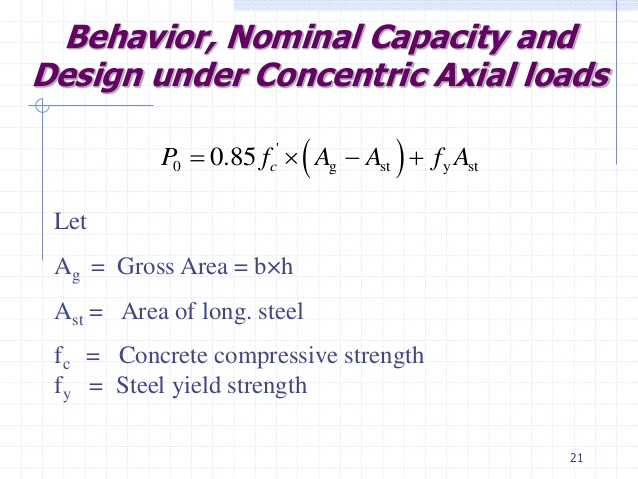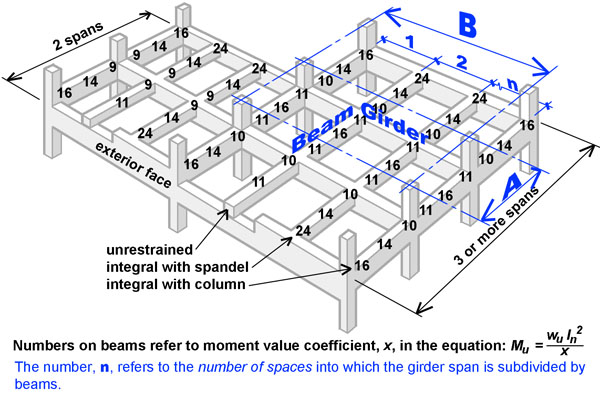

#CONCRETE COLUMN CAPACITY CALCULATOR HOW TO#
◆You Can Follow me on Facebook and Subscribe our Youtube Channelġ)what is concrete and its types and propertiesĢ) concrete quantity calculation for staircase and its formulaģ) how to calculate weight of mild steel plate and derive its formula what is fy in steel Suppose we have 100 cube of 150 mm size of M20 grade 95 cube should be able to with stand a comprehensive load of 20 Newton per mm square if not more than 5% fail than grade of M20 of concrete design is said to be pass under the test result.so fck is characteristics of comprehensive strength of concrete like that for M20and M25 fck is 20N/mm2 and 25N/mm2 respectively. in designing process 5% of specimen tested are expected to fail if more than 5% of specimen is fail is said to be fail under the test result. It is comprehensive strength of concrete define as characteristics comprehensive strength of 150 mm cube size in 28 days. Now we have to few things remember what is fck in concrete? B n: b 0.

The sides of the cone slope 1V:2H (in 2) Calculate bearing capacity. If the building height is 4 to 9 stories:Ĥ) calculate dead load of brick wall per metreĥ) ultimate load carrying capacity of column A 1 Area directly loaded in bearing (in 2) A 2 Area of the lower base of a frustrum, pyramid, cone, or tapered wedge contained wholly within the bearing support and having its upper base equal to A1. If the building height is 3 stories or less: P is steel in percentage say percentage as 1įor preliminary design use square columns. Here in the Table P is Axial Load Carrying capacity of column in KN. The axial Load carrying capacity column is arrived based on the formula Load carrying capacity of column will depend upon the percentage of steel reinforcement, grade of concrete and column size for various mixes and steel.Ĭoncrete grade & Axial Load carrying Capacity of column in KN (P)ġ. Hence about 1468.774 KN ultimate axial load carrying capacity of column for above this calculation. Pu = (0.4× 20×118116) N +(0.67×415×1884) NĬonverting into kilo Newton we have to divide by 1000 How to Load Calculation on Column Volume of Concrete 0.30 x 0.60 x 2.55 0.459 m Weight of Concrete 0.459 x 2400 1101.60 kg Total Weight of Column. Putting all the value in formula for ultimate axial load carrying capacity of column Putting the value of gross area of column and steel area subtracting both we get concrete in column We know that gross cross sectional area of column is equal to area of concrete in column and area of Steel in column To calculate a volume of steps you would need the following measurements: number of stairs, tread (inches), riser (inches), width (feet).1) first we have to calculate gross cross sectional area of columnĪg = gross cross sectional area of columnĢ) second we have to calculate area of Steel in columnģ) now we calculate area of concrete in column To calculate a barrier curb and gutter volume please have these measurements ready: length (feet), flag thickness (inches), gutter width (inches) and curb height (inches) LENGTH: If you are making a concrete column you would have to know the diameter of the column and the height of it. LENGTH:Ĭoncrete column can be used as a base for poles and other structures. Use the calculator below to help you estimate the amount of concrete needed for the wall you are working on.

Concrete wall usually has height and length measured in feet while wall thickness is measured in inches.

The difference between a concrete footing and a concrete wall is in measurements. Please refer to your design requirements to get exact measurements. A common width of 16 to 20 inches can be used to support a mid range house built on the typical soil. Width of the footings depends upon the type of the soil. LENGTH:Ī concrete footing is used as a foundation for outdoor structures such as houses, decks or porches. Please use the calculator below to give you some estimate of the concrete amount. Before any pour you need to know how much concrete will be needed. Thinner slabs can be used for exterior paving. Commonly, concrete slabs are between 4 and 20 inches thick and are used for a purpose of floor and ceiling construction. Often those slabs have steel reinforcement. A concrete slab is commonly used as a base element in modern buildings.


 0 kommentar(er)
0 kommentar(er)
